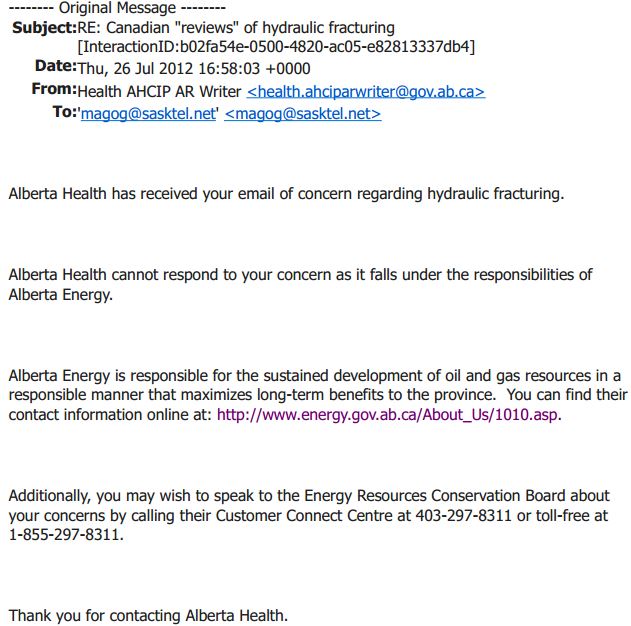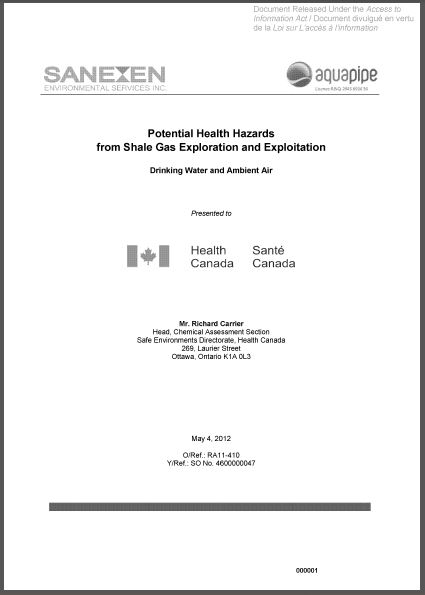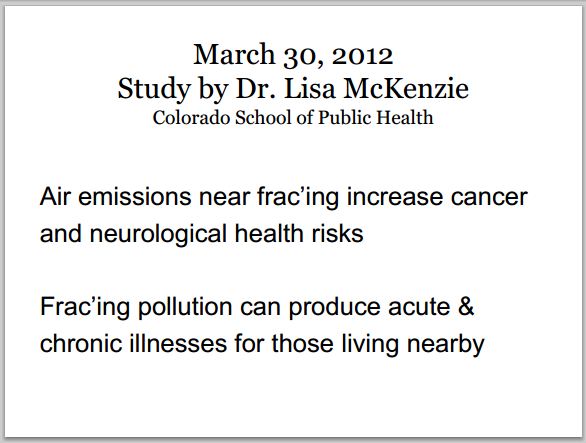Fracking Wells Could Pollute The Air Hundreds Of Miles Away by Katie Valentine, April 30, 2015, Think Progress
Air pollution from hydraulic fracturing operations can likely travel hundreds of miles, even into states with little or no fracking, a new study has found.
The study, published in the journal Atmospheric Environment, looked at hourly measurements of air pollutants like ethane and methane — gases that are found in natural gas — in Baltimore, Maryland and Washington, D.C. between 2010 and 2013. It found that ethane measurements increased by 30 percent between 2010 and 2013 in the region. The researchers focused on ethane because they couldn’t find enough data for methane emissions during the time period, and ethane is the second-most abundant compound in natural gas. Ethane spikes in Maryland and D.C.’s air isn’t good news for residents of the region: when ethane is breathed in, it can cause nausea, headaches, and dizziness.
But Maryland doesn’t currently allow fracking — former Gov. Martin O’Malley didn’t propose fracking regulations until the end of his term, and the state didn’t have any fracking between 2010 and 2013. So the researchers compared the ethane data to natural gas production in neighboring states atop the Marcellus shale play, including West Virginia, Pennsylvania, and Ohio. By doing so, the researchers found that the ethane emissions they found in Maryland appeared to be coming from these neighboring states’ natural gas operations.
“As shale natural gas production continues to expand, this increasing trend will continue in downwind regions until more efficient control technologies are applied,” the authors write in the study.
The authors reviewed levels of ethane in Atlanta, Georgia, a city that isn’t downwind of fracking operations, and found no increase in ethane levels between 2010 and 2013. They were also able to rule out other potential sources of the ethane, including natural gas storage fields in nearby Garrett County, Maryland, and vehicles. Neither of these potential sources saw a spike in natural gas use between 2010 and 2013. But, the report notes, Pennsylvania and West Virginia “house thousands of wells responsible for a tenfold increase in natural gas production volumes from 2009 to 2013.”
… “What these results mean to me is that we’ve got strong indications that it’s a regional issue,” author Sheryl Ehrman, chemical and biomolecular engineering professor at the University of Maryland, said in a statement.
… The study states that, along with ethane, gases like methane and other pollutants could also be traveling across state borders, something that could cause major impacts on air quality and ozone levels in cities downwind of fracking operations.
Other studies have illustrated fracking’s link to air and water pollution. One study of southwestern Pennsylvania fracking wells last year found that the wells released methane at rates 100 to 1,000 times higher than estimates by the EPA.
… A study last year also confirmed that fracking operations have contaminated well water in multiple states, and another found that methane concentration of residential water wells at Pennsylvania homes one mile from fracking wells was six times higher than it was in homes located farther away from wells. The study found that ethane levels were also elevated in water of homes closest to wells.
Health problems, too, have been linked to this pollution: a study last year found higher rates of illness in Pennsylvania households located close to fracking wells than in households farther away. [Emphasis added]
Study links air pollution in Baltimore, DC to fracking outside Maryland by Timothy B. Wheeler, April 30, 2015, Baltimore Sun
Even though Maryland has yet to permit any hydraulic fracturing for natural gas, emissions linked to the controversial drilling technique have been detected in the air in Baltimore and Washington, according to a new study.
In a paper published in the journal Atmospheric Environment, University of Maryland scientists reported finding that levels of ethane, a component of natural gas, rose 30 percent from 2010 through 2013 in air samples taken at a monitoring station in Essex.
A similar spike in ethane levels was detected at a monitor in Washington near Howard University – but not in Atlanta, where there is no fracking occurring in neighboring states.
The UM researchers say they couldn’t find anything in Maryland that could account for such increases. Indeed, levels of other air pollutants responsible for summertime smog have declined significantly since the 1990s.
But in reviewing air circulation patterns in the Mid-Atlantic region, researchers found that the bulk of prevailing winds reaching Baltimore and Washington passed over areas of Pennsylvania, West Virginia and Ohio where there is widespread drilling for gas.
“What we’re trying to do is wave a little flag,” said Sheryl H. Ehrman, a co-author of the paper and chair of UM’s chemical and biomolecular engineering department. “It looks like we’ve got a problem. I think we’ve got a regional issue.”
The study, which was underwritten in part by the Maryland Department of the Environment, comes as the Hogan administration mulls adopting regulations to allow hydraulic fracturing, commonly called “fracking,” in western Maryland.
Rules proposed under former Gov. Martin O’Malley would mandate control and reporting of air emissions from wells. Hogan administration officials have yet to say whether they will stick with or change such requirements.
… Ethane is a relatively minor ingredient of natural gas, while the main component is methane, a potent greenhouse gas. But the ethane spike picked up by the UM study is “a canary in the coal mine,” said Ehrman. There aren’t similar data tracking climate-altering methane and other pollutants produced by gas extraction, she said.
“If we’re seeing the ethane what else might we be seeing?” she asked. [And what toxic mystery frac chemicals are we breathing in our frac’d community air, and in our showers and homes?]
A Carnegie Mellon University study projects that gas production from the Marcellus shale formation, which stretches from New York through western Maryland to the Carolinas, could account for as much as 28 percent of the smog-forming air pollution in the region by 2020. Smog-forming and fine particle emissions from fracking operations could undermine the progress made to date in clearing the air, Ehrman suggested.
Oil and gas industry representatives disputed the study. Joseph P. Massaro, spokesman for Energy in Depth, an arm of the Independent Petroleum Association of America, said the Environmental Protection Agency and others have determined that air emissions have declined in spite of, or because of, growing production of natural gas. [Isn’t it fabulous that citizens around the world no longer believe industry and regulator frac lies, study after study?] [Emphasis added]
Regional air quality impacts of hydraulic fracturing and shale natural gas activity: Evidence from ambient VOC observations by Timothy Vinciguerraa , Simon Yaoa , Joseph Dadziea , Alexa Chittamsa , Thomas Deskinsa , Sheryl Ehrmana, and Russell R. Dickerson, June 2015, Atmospheric Environment Volume 110, June 2015, Pages 144–150
Highlights
• Ambient VOC measurements from EPA PAMS sites were analyzed.
• Ethane concentrations have increased recently in the Baltimore/Washington area.
• Shale natural gas operation emissions appear to be transported downwind.
Abstract
Over the past decade, concentrations of many anthropogenic pollutants have been successfully reduced, improving air quality. However, a new influx of emissions associated with hydraulic fracturing and shale natural gas operations could be counteracting some of these benefits. Using hourly measurements from Photochemical Assessment Monitoring Stations (PAMS) in the Baltimore, MD and Washington, DC areas, we observed that following a period of decline, daytime ethane concentrations have increased significantly since 2010, growing from ∼7% of total measured nonmethane organic carbon to ∼15% in 2013. This trend appears to be linked with the rapidly increasing natural gas production in upwind, neighboring states, especially Pennsylvania and West Virginia. Ethane concentrations failed to display this trend at a PAMS site outside of Atlanta, GA, a region without new widespread natural gas operations. [Emphasis added]
[Refer also to:
Among the key findings:
- 96% of all studies published on health impacts indicate potential risks or adverse health outcomes.
- 87% of original research studies published on health outcomes indicate potential risks or adverse health outcomes.
- 95% of all original research studies on air quality indicate elevated concentrations of air pollutants.
- 72% of original research studies on water quality indicate potential, positive association, or actual incidence of water contamination.
- There is an ongoing explosion in the number of peer-reviewed publications on the impacts of shale or tight gas developments: approximately 73% of all available scientific peer-reviewed papers have been published in the past 24 months, with a current average of one paper published each day.
Anthony Ingraffea, PhD, Dwight C. Baum Professor of Engineering, Cornell University, said, “In 2008*, when New York State first declared a moratorium on fracking, only six peer-reviewed papers on the health and environmental impacts had been published. Now there are more than 400, and the vast majority show a clear and present danger. What’s more, many problems are unfixable by regulations of any kind.*
…

…
…


